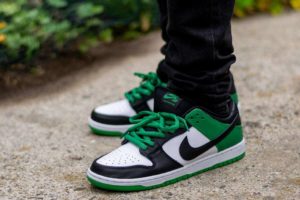They both have “Dunk” in the name with a similar, but not exactly the same, fit. In this article I’ll break down the different factors as far as Dunk sizing goes for SB and non-SB versions.
Nike Dunk vs SB Dunk Sizing
Both Nike Dunks and SB Dunks technically fit true to size. In a direct comparison however, modern Nike Dunks fit a bit on the large side while Nike SB Dunks are more snug.

Fits a bit snug at true to size. Either break them in
or go a half size up.
Shop SB Dunks: eBay
Traditionally, SB Dunks have more padding and Zoom Air technology in the insoles. The SB Dunk low in particular generally has an extra padded “fat” tongue.
Non-SB Dunks (or “regular” Dunks) tend to use very little padding. Additionally, most GRs (General Releases) tend to use a stiff, plasticky leather. This combination gives regular Dunks a roomier feeling at the same size right out of the box when compared to their SB counterparts.
So while both technically fit true to size, some pairs of non-SBs might fit a little large (maybe enough to go down a half size, but not always). Conversely, some pairs of SBs might fit a little small (I personally used to go a half size up rather than suffer through a break-in period).
By the way, if you want a pair of SB Dunks for yourself but are struggling to get a pair, check out this article.
Differences in SB Dunk Sizing (Older Pairs vs Newer Pairs)
SB Dunks fit differently depending on materials and release year. Newer pairs overall tend to be on the snug side, while older dunks are more forgiving.

The softer leathers found on an older release like
this means they fit a lot more comfortably at true
to size right out of the box.
Shop SB Dunks: eBay
This is due to a slightly different construction on newer SBs. Pairs produced after the 2010s tend to have more and springier padding combined with sturdier materials. Older releases tended to use more pillowy padding and pliable materials. This all contributes to the more “snug” feel on SB Dunks right out of the box. The shoes are meant to be broken in a bit more.
Materials play a role as well, so if softer or more premium leathers and suedes are used on a release, it affects how roomy the sneaker feels on foot. Older releases tend to utilize softer and cushier materials while newer releases tend to go with sturdier, more resilient materials. Perhaps the latter is better for skateboarding, but for casual wear it can be a pain to break in some too-tight SB Dunks.
Differences in Dunk Sizing (Older Pairs vs Newer Pairs)
Nike Dunks will feel different on feet depending on materials and release year. They generally feel roomier on feet when compared to an SB Dunk.

The 2001 version of this release shown here has
a very forgiving fit with nice, soft leather uppers
Shop Dunks: eBay
Newer Dunks overall tend to be on the stiff side for me, while earlier releases have the opposite. Older releases tended to use softer padding and flexible materials. While the stiffness on SB Dunks exaggerates the snug feel, for regular Dunks, the feel is much larger internally.
In general, the stiffer the material (patent leather, stiff synthetic leather), the more likely true to size is the move on a pair of Nike Dunks. On thinner leathers and more pliable materials like suede, half size down might work as well. I’ve often been able to size down on older releases (1999-2005 or so), but less so with modern releases. Even if a pair of non-SB dunks is naturally on the big side, if the materials are rigid like a modern pair typically is, the sneaker could still be too stiff to size down comfortably.
Nike Dunk Low vs High; SB and regular Dunks
Both SB and non-SB Dunks tend to fit roomier as hightops. This is especially pronounced on the SB Dunk.

Highs generally fit larger than lows, although
stiff materials can still make them feel as if they fit
differently.
Shop SB Dunks: eBay
While Dunk and SB highs lock down your ankle area more than lows, internally both tend to feel slightly larger than their counterparts.
With SBs, there is simply more intrusively placed padding on the lows, particularly on the versions with fat tongues. The ankle area on the low has more stiff padding to make up for the lack of a taller cut on the high.
With non-SBs, there’s less of a difference, but generally the highs tend to have roomier interiors.
That said, a lack of flexible materials used on most modern releases can have SB Dunk highs still feeling snug on feet, even with less overall padding. Regular Dunk highs will feel about the same around the toebox area (if not a bit roomier) when compared with lows, and so will SB highs. However, if the materials are not pliable, SB Dunk highs can have a similar lack of step-in comfort and lengthy break in. Even with the looser overall fit!
So… True to size… but not really?
As you can now tell, there are several factors with SB and regular Dunk sizing. The main things to consider before getting a pair are the year and materials used on the pair in question.
When all else fails though, go true to size. Just be mindful that SB Dunks might need some breaking in and non-SBs might need to be laced a little tighter. After either type is broken in, several wears down the line, even modern releases will accommodate to the wearer’s foot to some degree.
Personally, I’m not one for prolonged sneaker discomfort, so on a lot of modern SBs I’m going up half a size even if the sneaker winds up fitting slightly long.
Need to translate your size from Mens -> Women’s, UK or JP sizes? Try my new shoe size calculator.
Shop SB Dunks Here:
- Browse SB Dunk eBay Listings
